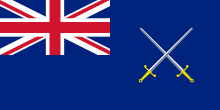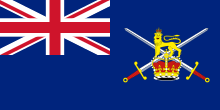17 Port and Maritime Regiment RLC
| 17 Port & Maritime Regiment RLC | |
|---|---|
 Full ahead together | |
| Active | 1949 - Present |
| Country |
|
| Branch |
|
| Role | Logistics |
| Size | 548 personnel |
| Part of | 104 Logistic Support Brigade |
| Garrison (Regional Command) | Solent Station (11 Infantry Brigade) |
| Mascot(s) | Seahorse |
| Corps |
|
| Insignia | |
| Tactical recognition flash |
 |
17 Port and Maritime Regiment is a regiment of the British Army's Royal Logistic Corps.[1] The unit is the Army's only regular Port & Maritime capability, though it is twinned with 165 Port Regiment RLC, of the Army Reserve. More recently, the unit now also encompasses the Army's only Vehicle Support Specialist, Operational Hygiene, and Mortuary Affairs capabilities; the later two tasks / roles having been assigned to the Regiment on the disbandment of 23 Pioneer Regiment RLC in 2014. It also operates the only military Dive Team in the RLC.[1]
Its primary role is to conduct military logistical operations using ports (either well founded or bare base) or over beaches, worldwide, in support of the British Armed Forces.
The Regiment is based out of McMullen Barracks in the village of Marchwood, on the west bank of Southampton Water, on the fringe of the New Forest. The barracks sits immediately adjacent to Marchwood Military Port, the MoD's Sea Mounting Centre (SMC)[2] - 17 P&M Regt manages a number of facilities in the SMC, and garage all of their vehicles and vessels there, though they are two distinct military units and sites. However, 17 P&M Regt provides personnel to support the operation of the SMC (primarily movement control and stevedore support), which serves to provide regular on-the-job training opportunities for the Regiment, whilst minimising the SMC's requirement for contractor support.
History
The Regiment was first formed as 17 Port Training Regiment Royal Engineers, at the existing Marchwood Military Port (near Southampton), Hampshire in 1949.[3] At that time, it was also responsible for training all ranks in Port and Inland Water Transport trades.
The Regiment initially comprised 51 and 52 Port Squadrons RE. It was later joined by 53 Port Maintenance Squadron RE. These former Royal Engineers Squadron numbers are still in use with the Regiment to this day. On 15 July 1965, the Regiment transferred to the Royal Corps of Transport (RCT)[4] and 17 Port Regiment Workshop REME (Royal Electrical & Mechanical Engineers) was formed at that time.[5]
The Regiment was originally accommodated in a war time Nissen hut type of camp in the field that is just beyond the northern boundary of Byams House, which became the Officers Mess.[6] Traces of the concrete bases of the huts can still be found in the grounds of the current barracks. Entrance to the camp and the Guard Room were in Byams Lane. McMullen Barracks was built in 1956, named after Major General Sir Donald McMullen CBE, who was the Director of Transportation (RE) in World War 2.
In 1993, the Regiment was transferred to the Royal Logistic Corps (RLC), on amalgamation of the RCT with four other Corps.[7] It kept its role and organisation, but shortly afterwards took 79 Railway Squadron RLC (a former RE Squadron) under command, which then became a Port Clearance (later Port Enabling) Squadron RLC, keeping one Rail Troop. In 2005, 54 Port Squadron RLC was formed but was disbanded in 2014.
Ensigns of British Army vessels


Originally there was no British Army Ensign, the crossed swords ensign being the ensign of a corps, and the task of designing an Army Ensign was given to HQ Maritime Group RCT Portsmouth, who produced a Blue Ensign defaced by crossed swords superimposed with the royal crest. It was approved by the Queen and announced in Army Order 53/66, and Defence Council Instruction (General) 62/67. The ensign was first flown on 17 May 1967 by Tank Landing Craft engaged in Exercise Wagon Trail. The Army Ensign was the army equivalent of the navy's White Ensign, while the crossed sword ensign was comparable to the vertical anchor Blue Ensign of the Royal Fleet Auxiliary Service. The army copied navy tradition by flying the Union Jack in the bows of ships being launched, with the Army Flag (instead of the Admiralty Flag) amidships. The last HMAVs, Arakan and Ardennes, were decommissioned in 1998, and the Army Ensign became dormant.[4] The crossed swords ensign remains flown to this day on all vessels operated by 17 Port and Maritime Regiment RLC, whose members also wear it on their dress uniform shirts and distinctive blue jumpers.
Operations
Since its formation, 17 Regiment has operated in virtually all those zones in which the British Army has fought or been concerned. These include Korea, Christmas Island, Suez, Tobruk, Borneo, Belize, the Falkland Islands, the Gulf War, Angola, The Bosnian war of the 1990s, the Kosovo war, Operation TELIC in Iraq and Kuwait in 2003, and Operation HERRICK in Afghanistan (primarily with personnel operating out of Pakistan, but with a number of specialist trades operating in key bases in Afghanistan itself).
In 2011 and 2012, the Regimental Headquarters and elements from the Squadrons deployed as the Theatre Logistic Regiment in Camp Bastion. Later in 2012, the regiment was required at short notice to set up and run the accommodation camp at Tobacco Docks on the river Thames in London, in support of the military personnel who were in turn supporting the 2012 London Olympics.[8] Lastly, in 2013, the Regiment deployed on a United Nations Peace-keeping tour to Cyprus (Operation TOSCA).[9]
Maritime Operations
Post World War 2, military vessels have operated in support of many major operations, such as in the Suez crisis, Belize, Borneo and especially in the Falklands War, where over 75% of all stores were landed by Mexeflote Rafts,[10] which is now the principal craft in service today with the Regiment, following the recent retirement of the Ramped Craft Logistics (RCLs).
Rail Operations
The latest military rail operations were in the Kosovo crisis, when 79 Railway Squadron RLC operated the line between Thessalonica in Greece to Kosovo in Serbia. During Operation Telic in Iraq in 2003, Rail Troop of 79 Port Clearance Squadron RLC opened up the rail link between Basra and Baghdad, in cooperation with a Royal Engineers Specialist Team.[11]
Sub-units
Current
The current units are:
- 51 (Port) Squadron RLC
- 52 (Port) Squadron RLC
- 53 (HQ & Enabling) Squadron RLC
- Workshops REME
Historical
The former units were:
- 79 (Port Enabling) Squadron RLC
- 54 (Port) Squadron RLC (Disbanded in May 2014).
Associated units
Current
The current units are:
- 165 Port Regiment RLC
- Headquarters Sea Mounting Centre (HQ SMC), Navy Command
- 73 Squadron ("The Port & Maritime School"), 25 Training Regiment RLC
- 460 Port Troop, East Cove Military Port, Joint Force Logistics Unit (JFLU), British Forces South Atlantic Islands (BFSAI)
Historical
The former units were:
- 20 Maritime Regiment, Royal Corps of Transport (RCT).
- 417 Maritime Troop, British Forces Cyprus (BFC)
Equipment
Current
It operates a wide variety of vehicles, plant, and vessels.[12]
Maritime
Current vessels in use are:
- Army Workboats (AWB)
- Combat Support Boats (CSB)
- MEXEFLOTE rafts
- Rigid Raider Craft
Historical
- Ramped Craft Logistics (RCL). Retired from service on 31 Mar 2014.
- Landing Craft Vehicle and Personnel, Mark IV (LCVP MkIV). Retired from service (with 17 P&M Regt RLC) in 2011, though still in use with 460 Port Troop in the Falkland Islands.
References
- 1 2 "17 P&M Regt RLC Homepage - British Army Website". Army.mod.uk. Retrieved 2014-11-04.
- ↑ Hansford, Roger (1 Oct 2014). Fawley's Front Line. The History Press. ISBN 978-0752498577.
- ↑ Major Lyndon M. Robinson, The Role of Britain's 17 Port & Maritime Regiment in Force Projection, Army Logistician, March–April 2005
- 1 2 Prothero, David (29 September 2004). "Board of Ordnance: Royal Corps of Transport Fleet (Britain)". CRW flags. Retrieved 18 September 2015.
- ↑ Kneen, J (1996). Craftsmen of the Army. Arborfield: Pen and Sword Books Ltd. p. 281. ISBN 0-85052-549-7.
- ↑ TCW (28 December 2013). "Byams House". Writing about writing. Retrieved 18 September 2015.
- ↑ "Forming Corps » Royal Logistic Corps". www.royallogisticcorps.co.uk. Retrieved 2015-09-18.
- ↑ "Olympics accommodation for additional military personnel - Announcements - GOV.UK". www.gov.uk. Retrieved 2015-09-22.
- ↑ "Peacekeeping in Cyprus - News stories - GOV.UK". www.gov.uk. Retrieved 2015-09-22.
- ↑ "Ship to Shore Logistics – 03 (History – 1982 Falkland Islands) - Think Defence". Retrieved 2015-09-18.
- ↑ Killblane, Richard (2010). US Army Use of Rail in Theaters of Operation (PDF). US Transportation Corps. p. 20.
- ↑ "Homepage - British Army Website". British Army. Retrieved 2014-05-05.